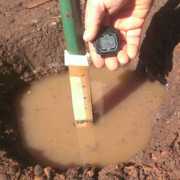Take a Soil Percolation Test
In the San Diego region, rainfall can be unreliable and insufficient to sustain landscaping without careful planning and a little help. An alternate water source, such as irrigation, may be required.
To make choices about the best, most efficient irrigation system for your landscape, it’s important to learn how well your soil drains.
How does your drainage perform?
Assessing how well water drains through your soil involves a simple percolation or drainage test. Follow these four steps:
1) Dig a hole the size of a one-gallon plant, about 12 inches deep and 12 inches wide.
2) Fill the hole with water and wait. Time how long it takes the hole to drain completely. This is needed to saturate the soil.
3) Once the water has drained and none is visible in the hole, fill the hole with water again.
4) Lay a stick or a shovel handle across the top of the hole, and measure the distance from the top of the hole at the handle or stick to the top of the water once every hour until it drains completely the second time. You may want to set a timer so you don’t forget to make your measurements.
Percolation and soil quality
If your soil drains more than four inches per hour: You have sandy soil. You need to add organic matter to improve the soil.
If your soil drains less than one inch per hour: Your soil needs extra help to drain. Try sheet mulching (link to page 19)
If your soil drains from one to four inches per hour: Good news, your soil is a sponge and drains well. This is the goal.
It isn’t difficult to build healthy, well-draining soil. Get our tips on how to create health soil here.
This article was inspired by the 71-page Sustainable Landscapes Program guidebook available at SustainableLandscapesSD.org. The Water Authority and its partners also offer other great resources for landscaping upgrades, including free WaterSmart classes at WaterSmartSD.org.




